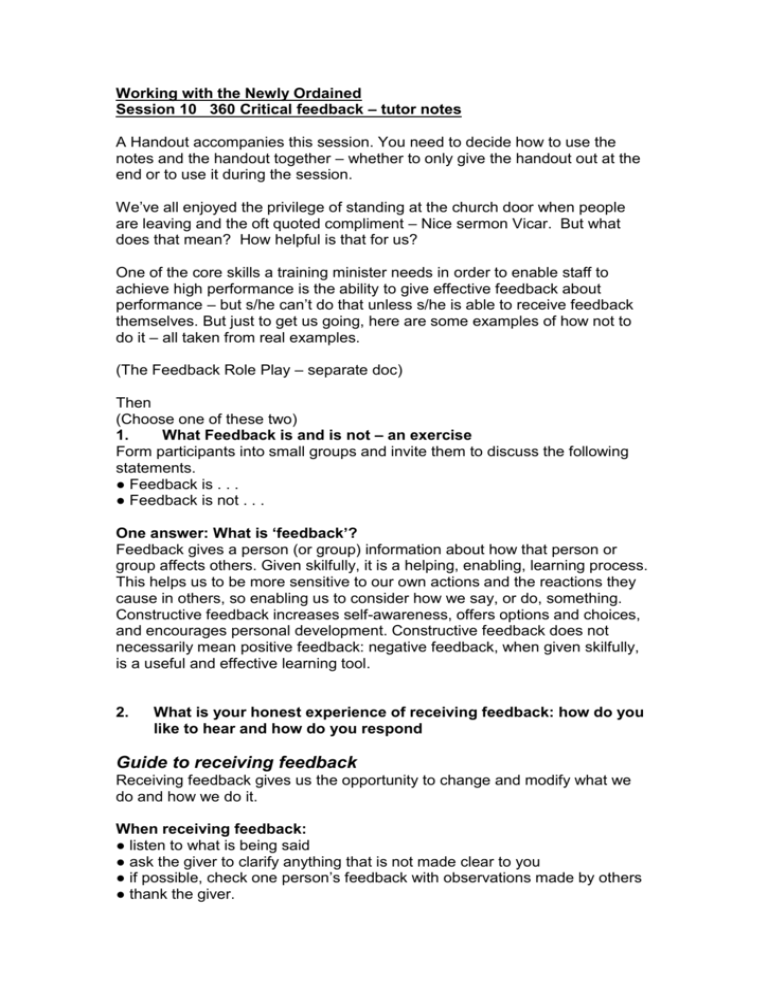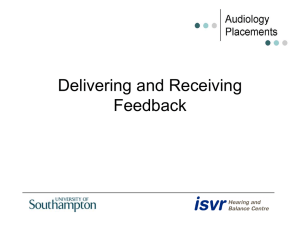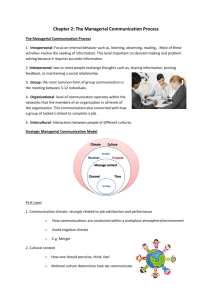Critical feedback – notes
advertisement

Working with the Newly Ordained Session 10 360 Critical feedback – tutor notes A Handout accompanies this session. You need to decide how to use the notes and the handout together – whether to only give the handout out at the end or to use it during the session. We’ve all enjoyed the privilege of standing at the church door when people are leaving and the oft quoted compliment – Nice sermon Vicar. But what does that mean? How helpful is that for us? One of the core skills a training minister needs in order to enable staff to achieve high performance is the ability to give effective feedback about performance – but s/he can’t do that unless s/he is able to receive feedback themselves. But just to get us going, here are some examples of how not to do it – all taken from real examples. (The Feedback Role Play – separate doc) Then (Choose one of these two) 1. What Feedback is and is not – an exercise Form participants into small groups and invite them to discuss the following statements. ● Feedback is . . . ● Feedback is not . . . One answer: What is ‘feedback’? Feedback gives a person (or group) information about how that person or group affects others. Given skilfully, it is a helping, enabling, learning process. This helps us to be more sensitive to our own actions and the reactions they cause in others, so enabling us to consider how we say, or do, something. Constructive feedback increases self-awareness, offers options and choices, and encourages personal development. Constructive feedback does not necessarily mean positive feedback: negative feedback, when given skilfully, is a useful and effective learning tool. 2. What is your honest experience of receiving feedback: how do you like to hear and how do you respond Guide to receiving feedback Receiving feedback gives us the opportunity to change and modify what we do and how we do it. When receiving feedback: ● listen to what is being said ● ask the giver to clarify anything that is not made clear to you ● if possible, check one person’s feedback with observations made by others ● thank the giver. After receiving feedback: ● think about what the feedback was saying about your behaviour ● consider what you may want to change or modify. Avoid: ● being defensive when receiving feedback – this prevents you from learning ● ignoring feedback afterwards. . We give feedback to enable people: ● to be aware of what they do and how they do it ● to learn, grow and develop. Feedback should focus on: ● what has been done or said, not on what we think that means ● what we observe happens, not on what we think about the person ● describing, not making judgements ● being specific, not generalising ● sharing your personal feelings and ideas, not giving advice ● giving only as much as the receiver can use, not everything you would like to give ● behaviour that the receiver can do something about – you can’t change attitudes but you can change behaviour ● starting with positive behaviour that needs approval and encouragement ● using ‘I’ statements: ‘I noticed that you . . .’ Giving skilled feedback Your objective in giving feedback is to enable the other person to develop and learn by becoming more self-aware. These good-practice guidelines will facilitate effective feedback. Start with the positive When offering feedback it can help the receiver to hear first what you like, appreciate, enjoy or what you found they did well. White, Anglo-Saxon culture sometimes emphasises the negative, the focus being on mistakes rather than strengths, and in the rush to criticise, the positive aspects are overlooked. If the positive is registered first, any negative is more likely to be listened to and acted upon. Be specific General comments are not very helpful when it comes to developing skills because they do not provide sufficient detail to be useful sources of learning. Comments such as, ‘you were great’ or ‘you were terrible’ are unhelpful in terms of learning unless what the person did that led to the use of the labels ‘great’ and ‘terrible’ can be pinpointed. It is extremely difficult to act upon general information and comments. Be descriptive rather than evaluative Describe your reactions by telling the person what you saw or heard and the effect it had on you. Simply commenting that something was ‘good’ or ‘bad’ is not informative and value judgements are likely to lead to defensiveness. ‘I felt you really were interested and concerned, because of your tone of voice and the way you listened’, is more likely to be useful and helpful than ‘that was good, I enjoyed it’. Take care with timing Feedback is most useful when offered as early as possible after the behaviour so that events and feelings are clearly remembered. However, it is important to be as sure as you can that the receiver is ready for the feedback at that time. In some situations, it may be more helpful to reserve the feedback until later. Offer alternatives In situations where you offer negative feedback, suggesting what could have been done differently is often more helpful than simply criticising. Turn the negative feedback into a positive suggestion. For example: ‘The fact that you all carried on with the task when Chris joined you seemed unwelcoming. I think if you had stopped for a moment to say hello and exchange names, Chris would have found it much easier to take part in the group.’ Check out Don’t immediately assume that the feedback you offer is clearly understood and the message received was the message intended. Check out with the other person to ensure understanding. It is also useful, where possible, to test the accuracy of your feedback by checking whether it is one opinion or a view that is shared. 10 Own the feedback Offering a universally agreed opinion of the ‘you are . . .’ type is an easy trap to fall into when giving feedback. All we can offer another person is our own experience of them at a particular time and it is important that we take responsibility for the feedback we offer. Starting with ‘I’ or ‘In my view’ can help to avoid the impression of being a judge. Don’t overdo it Providing an appropriate amount of feedback is important. When asked for comments and opinions there is a temptation to say everything and overwhelm the receiver, rather than to select the more appropriate and useful information, leaving the receiver to ask for more if wanted. Questions first Feedback that is dogmatic can be a hindrance rather than a help since it invites the taking up of opposing stances. Helping the receiver to think about where they want to be by posing reflective questions is more likely to help than making a statement. Try to be objective Objectivity is very difficult to achieve when giving or receiving feedback. Giving facts before opinions and describing observable behaviour can help avoid total subjectivity and can put observations into a context. Feedback should be given with care. To be useful, feedback requires the giver to feel concern and to care for the person receiving it – to want to help, not hurt the other person. Feedback should be given with attention. It is important to pay attention to what you are doing as you give feedback. This helps you to engage in a twoway exchange with some depth of communication.





